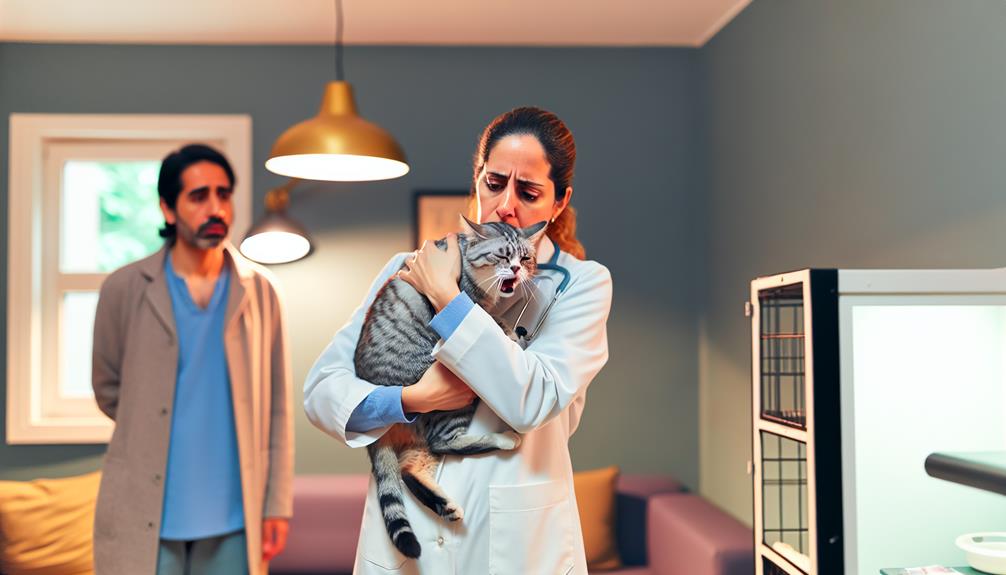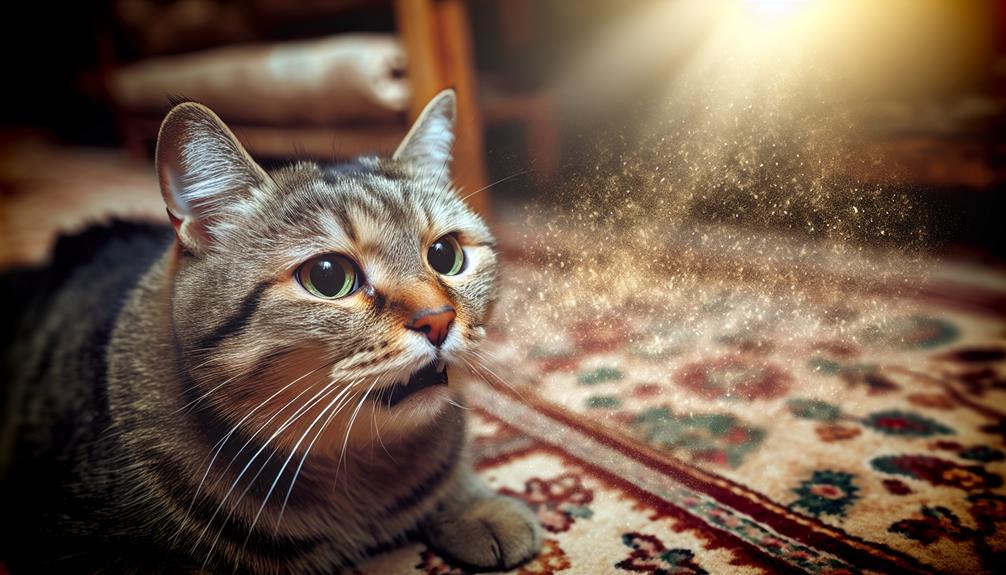When your cat's sneezes fill the air like sudden bursts of spring rain, it's natural to wonder what's going on. Sneezing in cats can be caused by a range of issues, from common allergies to more serious respiratory infections. It could even be something in your home environment that's irritating their sensitive nasal passages. Understanding what triggers these sneezes is essential for your cat's health. But how do you pinpoint the exact cause and know when it's time to see the vet? Let's explore the possibilities and find out what's best for your furry friend.
Common Allergies in Cats
Cats frequently suffer from allergies, much like humans do. Allergens can be inhaled, ingested, or come into direct contact with your cat's skin, leading to a range of symptoms such as sneezing, itching, and gastrointestinal issues. Two primary types of allergies in cats are seasonal allergies and food allergies.
Seasonal allergies, also known as atopic dermatitis, occur when your cat's immune system overreacts to environmental allergens like pollen, mold, or dust mites. These allergens are more prevalent during certain times of the year, hence the term "seasonal." Symptoms typically include sneezing, coughing, and itchy skin, particularly around the ears and face. You might notice your cat grooming excessively or developing bald patches due to persistent scratching. Antihistamines or corticosteroids are often prescribed to manage these symptoms, but identifying and minimizing exposure to the allergens is essential for long-term relief.
Food allergies, on the other hand, are triggered by specific ingredients in your cat's diet. Common culprits include proteins like beef, chicken, and fish. Unlike seasonal allergies, food allergies can cause symptoms year-round. Gastrointestinal symptoms such as vomiting and diarrhea are common, but they can also manifest as skin irritations and chronic ear infections. An elimination diet, where suspected allergens are removed and then gradually reintroduced, is the gold standard for diagnosis. Once identified, a hypoallergenic diet tailored to your cat's specific needs can help manage these symptoms effectively.
Understanding the types and triggers of allergies can greatly improve your cat's quality of life. Always consult your veterinarian for a proper diagnosis and treatment plan tailored to your cat's specific condition.
Respiratory Infections
When your feline friend starts sneezing, it might be more than just allergies—respiratory infections could be the culprit. Cats are particularly susceptible to respiratory infections, which can be classified mainly into viral infections and bacterial infections. Understanding the etiology, symptoms, and treatment options for these infections is essential for ensuring your cat's health.
Viral infections are the most common cause of respiratory issues in cats. Feline Herpesvirus (FHV-1) and Feline Calicivirus (FCV) are the primary agents. These viruses can cause sneezing, nasal discharge, and conjunctivitis. FHV-1 can also lead to chronic, recurrent respiratory problems, while FCV may cause oral ulcers in addition to respiratory symptoms. These infections are highly contagious, especially in multi-cat environments, and are typically diagnosed through PCR testing or virus isolation techniques.
On the other hand, bacterial infections often occur secondary to viral infections but can sometimes be primary pathogens. Bordetella bronchiseptica and Chlamydophila felis are notable bacterial agents. Symptoms include persistent sneezing, nasal discharge, and ocular inflammation. These infections are usually diagnosed through bacterial cultures or PCR tests. Antibiotic therapy is often effective in treating bacterial infections, with doxycycline being a common choice.
In both cases, supportive care plays an essential role. Ensuring your cat stays hydrated, maintaining a stress-free environment, and using humidifiers can alleviate symptoms. Vaccination is also a key preventive measure against these infectious agents. Regular vet check-ups can help in early diagnosis and management.
Understanding the role of viral and bacterial infections in your cat's respiratory health can guide you in seeking timely veterinary care, ultimately ensuring your feline companion remains healthy and happy.
Environmental Irritants

Exposure to various environmental irritants can also be an important factor contributing to your cat's sneezing. Both indoor and outdoor irritants can trigger a cat's sensitive respiratory system, leading to frequent sneezing episodes. Understanding these irritants is vital for providing a healthier environment for your feline companion.
Indoor irritants often consist of household dust particles. Dust can accumulate in carpets, furniture, and even on your cat's favorite resting spots. Regular cleaning and the use of air purifiers can greatly decrease dust levels, thereby reducing your cat's sneezing. Additionally, certain cleaning products, especially those with strong fragrances, can also act as respiratory irritants. Opt for unscented or pet-friendly cleaning solutions to mitigate this risk.
Outdoor irritants, such as pollen exposure, are another common cause of sneezing in cats. Pollen from trees, grasses, and flowers can be particularly troublesome during specific seasons. If your cat has outdoor access, monitor pollen counts and limit their outdoor time during high pollen periods. This can help minimize their exposure and subsequent sneezing.
To summarize, here are three key environmental irritants that can contribute to your cat's sneezing:
- Dust particles: Regular cleaning and air purification can help control this.
- Cleaning products: Choose unscented or pet-safe options to reduce respiratory irritation.
- Pollen exposure: Monitor pollen levels and restrict outdoor time during peak seasons.
Chronic Health Conditions
Chronic respiratory conditions can be a significant underlying cause of persistent sneezing in your cat. These conditions often involve long-term inflammation or structural abnormalities in the respiratory system. Feline asthma, for example, is an inflammatory condition affecting the lower airways. It can lead to symptoms such as wheezing, coughing, and sneezing due to the narrowing of air passages. Similarly, nasal polyps, which are non-cancerous growths in the nasal passages or sinuses, can obstruct airflow and irritate the nasal mucosa, resulting in frequent sneezing.
Common Chronic Respiratory Conditions in Cats
| Condition | Symptoms | Treatment Options |
|---|---|---|
| Feline Asthma | Wheezing, coughing, sneezing | Inhalers, corticosteroids, bronchodilators |
| Nasal Polyps | Sneezing, nasal discharge | Surgical removal, anti-inflammatory medications |
| Chronic Rhinitis | Sneezing, nasal congestion | Antibiotics, nasal flushes, anti-inflammatory medications |
Understanding these conditions is essential for effective management. Feline asthma, for instance, is often diagnosed through a combination of clinical signs, radiographs, and sometimes bronchoscopy. Treatment usually involves long-term inhaled corticosteroids to reduce inflammation and bronchodilators to open up the airways.
Nasal polyps, on the other hand, are typically diagnosed via rhinoscopy or imaging techniques like CT scans. Surgical removal is often necessary, followed by anti-inflammatory medications to prevent recurrence. Chronic rhinitis, which involves persistent inflammation of the nasal passages, can result from a variety of factors including infections and environmental irritants. It requires a tailored approach, often involving antibiotics and anti-inflammatory treatments.
When to Visit the Vet

In cases where your cat's sneezing persists or is accompanied by other symptoms such as nasal discharge, it's important to consult your veterinarian. Persistent sneezing can signal underlying health issues that require professional evaluation and treatment. It's vital to understand that sneezing causes can range from mild irritants to severe infections, and only a veterinarian can accurately diagnose and treat the underlying condition.
When you visit the vet, they will likely conduct a thorough physical examination and may recommend various diagnostic tests to identify the cause of your cat's symptoms. These tests can include:
- Blood Tests: To detect infections, inflammation, or other systemic conditions.
- Radiographs (X-rays): To visualize the nasal passages and identify any obstructions or abnormalities.
- Nasal Swabs and Cultures: To identify specific bacteria, viruses, or fungi causing the sneezing.
It's important to follow through with these diagnostic tests as they provide critical information for determining the appropriate treatment plan. Untreated respiratory issues can lead to more severe health problems, potentially affecting your cat's overall well-being.
Moreover, certain sneezing causes, such as feline herpesvirus or calicivirus, are highly contagious and can spread to other pets in your household. Early diagnosis and treatment can help manage these conditions and reduce the risk of transmission.
Conclusion
So, your cat's sneezing like it's auditioning for a feline remake of "Sneezy and the Seven Dwarfs"? It's not just a cute quirk. Whether it's allergies, respiratory infections, or chronic conditions, those sneezes are your cat's SOS signals. Dismissing them could lead you from mild dust allergies to a full-blown vet emergency. Remember, early diagnosis and treatment are key. So, don't wait for your cat to start writing its own medical drama—see the vet pronto!
